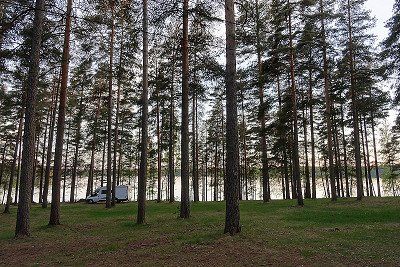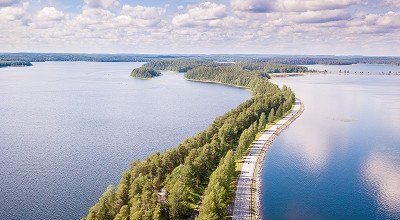Finland has topped the UN Happiness Report for several years in a row, ranking Finland as the happiest country in the world. Because even in summer, this Nordic country has so much to offer in terms of nature and tranquillity. Freeontour presents a trip around the Saimaa Lake District, part of the larger Finnish Lake District in the southeast of the country as inspiration for your next Scandinavian getaway.

Where exactly is the Saimaa Lake District ?
The Saimaa Lake District lies in southeast Finland, about a two-hour drive east of Helsinki. It's a paradise for RV travellers looking for rest and relaxation amidst stunning nature and water. As the name suggests, you're never far from a lake. The roads often run right along a lake, so that the journey itself offers countless breathtaking views – and you'll want to stop every few metres just to take it all in. The Saimaa Lake District has over 4,000 lakes and almost 14,000 islands and, with its labyrinthine lakescape, forms Europe's fourth largest natural freshwater lake. Lake Saimaa is the largest lake in Finland. The countryside is especially beautiful in summer – and you can enjoy it for practically 24 hours a day as the sun rarely sets and the nights are mild and bright. This is also the best time of year to visit the Saimaa Lake District as most campsites are only open during the summer months.

Alternatively, the right of public access to the wilderness in Finland allows you to spend several nights in one spot with a motorhome or caravan. Unlike in Sweden or Norway, motorised camping vehicles are not excluded from the right to roam in Finland. Nevertheless, free camping is not allowed everywhere: restrictions can often be found in cities and nature reserves. Therefore, pay attention to the signs and, if in doubt, look for another pretty site. And above all, don't damage nature and don't leave any rubbish behind. Rest areas are usually found in scenic locations, with seating under a tree or right by a lake. However, it's important to comply with the speed limits in Finland as the penalties are severe and depend on the driver's income. Even if the roads seem to be endlessly straight, keep in mind that speed cameras are often placed before and after town exits.
How to get to the Saimaa Lake District – by ferry to Helsinki
You can, in principle, get to the Saimaa Lake District completely on land via the Baltic States and Russia*. If you don't want to travel through Russia, you could take a Tallink Silja ferry, which runs seven times a day from Tallinn to Helsinki, and be in the Finnish capital in just two hours. If you want to drive less, you could take the ferry from Rostock to Nynäshamn in Sweden and then another ferry from Stockholm to Helsinki via Åland. An added benefit: Freeontour members receive a discount on the crossing and the cabin price at Tallink Silja.
*Due to the current political situation, travelling through Russia is possible, but subject to various conditions and limitations.

Stop #1: Helsinki, the white city by the sea
In summer, visitors can enjoy the many street cafés and festivals in the cosmopolitan, laid-back capital by the sea and take advantage of all that the White City of the North has to offer. Make sure you stop off at the magnificent cathedral, the Temppeliaukio Church built into rock and the futuristic, underground Amos Rex Art Museum.
A market is held by the harbour every day where you can try coffee and korvapuusti (Finnish cinnamon rolls) in the open-air cafés while watching the seagulls and the hustle and bustle. Or you can stroll through the nearby indoor market and try Finnish specialities straight from the producer, such as karjalanpiirakka (rice or potato pasty) or gravlax (cured salmon).

Afterwards, you can explore the Design Quarter and discover architecture, designer boutiques, pop-up stores and galleries as well as nice cafés and restaurants in addition to well-known Finnish designer brands such as Artek, Iittala and Marimekko and the Design Museum. This area stretches from the Kamppi to Punavuori and Kaartinkaupaunki districts, with 25 streets and 200 points of interest. After being on your feet for a while, relax in the Löyly Design Sauna or the Allas Sea Pool right by the harbour, which even has a pool containing Baltic Sea water. For instance, you could stay overnight at the Rastila Camping campsite, which is open all year round and lies right by the sea, with a public sandy beach and all the usual amenities. It will only take you 20 minutes to get from the Rastila metro station, which is within walking distance, to the city centre.

Stop #2: Discover the historic charm of Porvoo
Or simply go straight to the next stage of the trip... Take the E18 to get to Porvoo, the second oldest town in Finland, in just under an hour. Its most distinctive landmark are the red-painted 18th-century salt warehouses that light up the banks of the Porvoonjoki River below the Old Town. They once stored fruit, coffee, wine, spices and tobacco. Today they are used as cafés, flats or private storage rooms. Located on the old King's Road, Porvoo became an important trading hub in the 13th century, yet life here is pretty peaceful. The medieval Old Town with colourful wooden houses and narrow cobbled streets is charming, with craft and antique shops, galleries, museums, cafés and restaurants concealed behind the yellow, red, blue and green façades.
Opposite the church in Porvoo you'll find a monument dedicated to the poet Johan Ludvig Runeberg. His former home is now a museum. Not only did he write the lyrics to the Finnish national anthem, but he is said to have eaten small raspberry tarts topped with finely chopped almonds every day, which is why they bear his name. Runeberg tortes are eaten everywhere in Finland on 5th February, his birthday. However, they can be bought throughout the year only in Porvoo.
You can walk or cycle to the Old Town from the Camping Kokonniemi campsite.

Stop #3: Saimaa, every camper's dream – fishing, hiking & relaxing
We head further in to the Saimaa Lake District via the E75 or alternatively the E18 – a breathtaking water landscape made up of countless interconnected lakes and thousands of small islands, making it ideal for hiking, swimming, canoeing and fishing. You could catch some salmon, char or vendace for dinner using just a hook and fishing line, and you won't need a fishing licence to do so. If you're lucky, you might even get to see a Saimaa ringed seal, which only lives here in fresh water.
With so many things to do here, you can stay as long as you like and discover stunningly beautiful spots, stopping wherever you feel like it.

Stop #4: Island town of Puumala
Puumala is an island town in the Saimaa Lake District with a calm and laid-back atmosphere. It recently won an award for sustainable tourism, which only three places in Finland have achieved so far. You can hike along the Vehoniemi nature trail, take a boat tour on the lake or visit Puumala Church.
The bridge at the port offers great views. A lift takes you up to the café in the bridge tower where you'll have a bird's eye view of the many boats bobbing on the water.

Make sure you go on the Puumala Archipelago Route, a magnificent scenic trail for cyclists, which opened in the summer of 2017. This circular route is 60 kilometres long and goes through the most beautiful landscapes of Lake Saimaa, over islands, bridges and hills. You'll have to take the Norppa II bike ferry on the section between the islands of Hurissalo and Lintusalo. For instance, you could stay at the Camping Koskenselkä campsite in Puumala, where, like at almost all Finnish campsites, you simply have to book the beach sauna for the evening. You'll then have the wood-heated sauna all to yourself for one to three hours and can look out over the lake from the wooden terrace between sauna sessions or jump in from the jetty if you're feeling adventurous. Even if you're not really a fan of saunas, we recommend immersing yourself in this typical Finnish way of life – it's not for nothing that there's a saying that you haven't been to Finland if you haven't sweated in a sauna.

Stop #5: Savonlinna, the heart of the Saimaa Lake District
We now continue to Savonlinna by taking the 434, 435 and then the E14. The centre of Savonlinna lies partly on islands at a narrow point between the lakes Haukivesi in the north and Pihlajavesi in the south. Both lakes are part of the Saimaa lake system. Savonlinna is known for Olavinlinna Castle and the opera festival that takes place there annually. The castle, which was built in the 15th century and is considered one of the best preserved medieval castles in Northern Europe, has provided its impressive setting for the open-air festival every July since 1912. Savonlinna is especially beautiful to explore from the water, e.g. by sightseeing on a steamboat or as part of a canoe tour where you can explore the city yourself by paddling around.

Savonlinna's market square is right by the water and has been an important meeting place since the late 19th century. The stalls are full of both local and homemade products. And the market vendors are known for their love of storytelling. Drinking coffee at the market while enjoying the atmosphere around you is the closest you'll get to the Finnish way of life. Try one of the delicacies from the Savonlinna region, such as muikku (fried vendace) or lörtsy (a fried pie with a sweet or savoury filling).
There are several pitches and campsites near Savonlinna, including Vuohimäki Camping right by the lake where you can even rent a boat or the sauna.

Stop #6: The largest Christian wooden church in the world in Kerimäki
Just 25 kilometres from Savonlinna, via Route 71, is Kerimäki and the world's largest Christian wooden church: 45 metres long, 42 metres wide and 27 metres high. The church, which dates from the mid-19th century and still has the largest church interior in all of Finland today, can seat 3,400 people. Obviously too large for a place with just 5,000 inhabitants, for which there are several – unproven – explanations. A popular reason is that the builder of the church mixed up the units of length. The architect Anders Fredrik Granstedt is said to have designed the plans in feet whereas the European builder, who was used to calculating and building in metres, failed to convert the measurements.
The church cannot be heated, which is why it's now only used for church services in summer. Only at Christmas does the congregation gather in this large church, which is then heated by hundreds of candles and visitors.

Stop #7: Space and freedom in Rääkkylä
With around 2,000 inhabitants, the small municipality of Rääkkylä lies roughly 30 kilometres south of Joensuu on a peninsula between Lake Orivesi and Lake Pyhäselkä, which are part of the Saimaa Lake District. It's the perfect place to leave all your cares behind. The small Koivuniemi campsite in Rääkkylä offers an abundance of tranquillity, space and freedom in a meadow right by the lake. And as is the norm at campsites in Finland, space is paramount – you can park your motorhome wherever you like, even right under the trees or near the water, and still be far enough from your neighbours. This large campsite is run by an artist couple, so there's always works of art to be discovered. Dogs are also welcome, as at most campsites in Finland. If you want to be active, you can set off on hikes and bike tours from here. And just as you'd expect, a sauna is not too far away.



